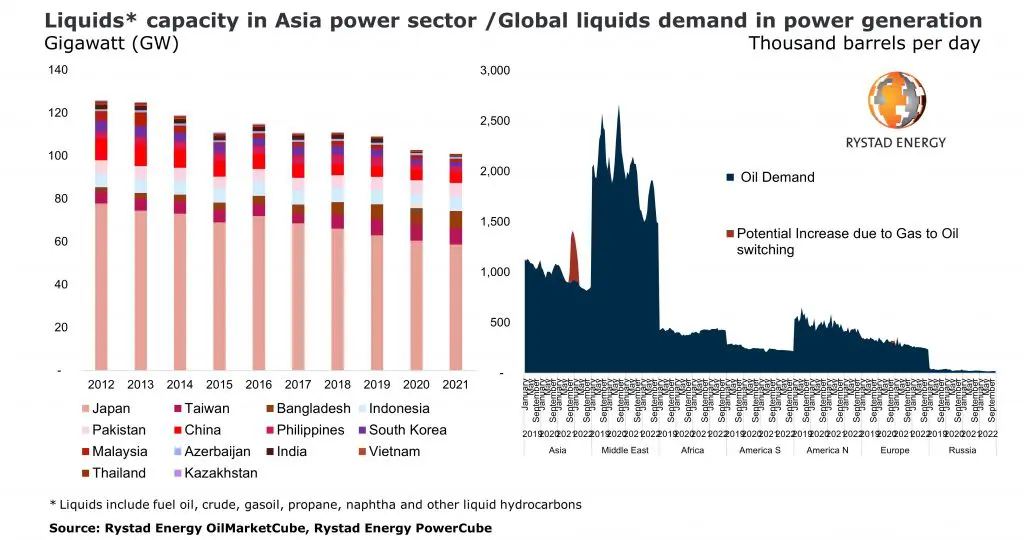The recent rally in LNG prices in Europe and Asia has dramatically widened the economic incentive to switch from natural gas to oil in power generation, according to a Rystad Energy report.
Steep carbon regulations and operational constraints limit Europe’s ability to burn oil in power plants, but Asia has more flexibility.
If the gap between LNG and oil prices remains wide, Asia would boost oil demand by 400,000 barrels per day on average over the next two quarters, Rystad said, adding this would support already high oil prices.
Utilization of oil-burning infrastructure to surge
Asia’s liquid-burning capacity for power generation has declined over the past 10 years, but still sits at about 100 gigawatts, mostly in Japan, Taiwan, Indonesia, Bangladesh and Pakistan, the consultancy said.
Asia’s current oil consumption for power generation fluctuates at around 900,000 bpd, which leaves a monthly unused and available oil-burning capacity of bit more than 550,000 bpd.
As the continent adds 400,000 bpd on average in the next six months, utilization of the oil-burning infrastructure would surge, it said.
“When we look at the potential uplift in demand of 550,000 bpd, Japan would account for the lion’s share with more than 300,000 bpd, followed by Indonesia (58,000 bpd), Taiwan and Bangladesh (39,000 bpd each) and Pakistan (33,000 bpd),” Rystad said.
This assumes a load factor of 0.7 for all the liquid capacity, and also takes into account that some older natural gas plants can switch to oil temporarily.
“This is a significant increase for Asia, when looking at its current oil-to-power use. From a global oil balance perspective too, this would be a significant shift, and it provides support to the current rally in oil prices,” says Claudio Galimberti, senior vice president on Rystad’s oil markets team.

Asian LNG prices to stay “well above” $20 per MMBtu
Rystad Energy looks at the spot and futures prices of the JKM and TTF gas price benchmarks and considers five different thermal efficiency scenarios for natural gas and oil in power plants.
It is normally not economical to run oil at any of the five efficiency levels – the only exception in 2020 and 2021 was in January 2021, when the polar vortex caused oil prices in Japan to jump, the consultancy said.
However, as Asian natural gas prices are currently forecasted to shoot up and stay well above $20 per MMBtu over the coming Northern Hemisphere winter, there is clear upside for oil demand in this region – unless the oil price were to increase even faster and cause the price spread to LNG to narrow, it said.
Liquid-burning power plant capacity stands at about 2.6% of the total installed capacity in Asia, but usually actual power generation coming from liquids is lower.
Pure liquids plants have typically had very low utilization factors, both for economic and environmental reasons.
Overall liquids generation in Asia only accounted for around 1% of total power generation last year, down from around 3% a decade earlier, Rystad said.

